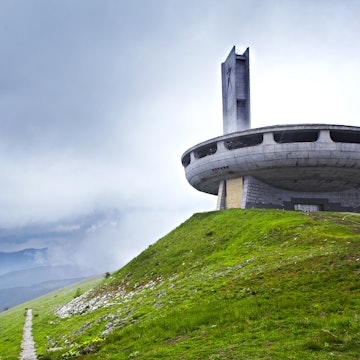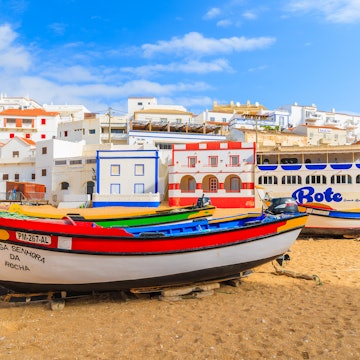

In between exploring Sofia’s food scene and many parks, don’t miss landmarks like the iconic Alexander Nevski Cathedral. LouieLea/Shutterstock
Bulgaria’s capital is a captivating blend of vibrant culture, rich history and contemporary urban charm. Think ancient ruins and stunning Orthodox churches alongside street art. Lively markets and tranquil parks. Restaurants that serve up traditional Bulgarian fare and the trendiest brunch offering. All in an atmosphere that’s truly welcoming – and delightfully affordable.
Ready to discover the best of Sofia? Let’s dive in.
When should I go to Sofia?
The best time to visit Sofia is between May and October, when temperatures are warm, the sun is shining and visitors can get outside and explore. The spring months of May and June see a higher chance of rain, but plenty of sunny days, too.
The weather is warmest in the summer months, with average temperatures of 25°C to 35°C (77°F to 95°F) from June to September. Yet summer is also one of the quietest times in Sofia since so many Bulgarians ditch the city to vacation on the seaside. These months – and especially August – can be a good time to discover Sofia without too much traffic or crowds.

Is it easy to get in and around Sofia?
Yes, very: Sofia offers a convenient mix of metro, trams and buses. Given the frequent traffic, the extensive, reliable metro is your best bet for getting around quickly. (It even reaches the airport.) You don’t need to purchase a ticket for public transit; all you’ll need to pay your fare is a contactless debit or credit card. Alternatively, opt for a prepaid card that suits your stay – whether it’s for a day, 10 weekly trips or even longer.
Sofia also has introduced shared bike-rental stations. While cycling isn’t yet a major part of local culture and drivers have much to learn about sharing the road, it can still be a fun way to get around. Look at the map of bike lanes in the city to get an idea of the easiest (and safest) way to get where you want to go.
If you prefer driving, consider using Spark, a short-term car rental service that offers flexibility without the hassle of lengthy contracts. Keep in mind that driving and parking in Sofia can be a challenge, especially during peak hours. If you truly don’t need a car, it’s probably best to avoid getting one. The city center operates on a zoned parking system, which can be tricky to navigate.

Top things to do in Sofia
Step into the city’s rich history
In Sofia, rich history is around every corner of a vibrant, busy capital. Start at the partly covered archaeological complex of Serdica, whose Roman ruins lie next to contemporary buildings by Serdika metro station.
The city’s Orthodox heritage is also widely visible, with stunning landmarks like the Alexander Nevski Cathedral, the 4th-century CE St George Rotunda and the medieval St. Petka Temple. To explore Sofia’s Communist-era history, check out the Red Flat, a preserved apartment that evokes everyday life in that period, or take a fun and informative “Communist Trabant Tour,” which offers more perspective on this moment in history.
For a deeper dive, the Sofia History Museum, housed in the beautiful former Central Mineral Baths, covers the gamut of the city’s past. The friendly guides at Free Sofia Tour can also help you learn a few facts and stories about Sofia’s past and present.

Dive into the culture of street art and graffiti
Sofia’s vibrant street art adds a colorful layer to the city’s urban fabric. As you explore, you’ll spot stunning murals that creatively reflect social issues and local culture. Don’t miss The Hug by Nasimo, one of Bulgaria’s top graffiti artists, or the bright and lively Tulip Girl near Serdika metro station. Another hidden gem is the artwork behind the Sofia Opera, while the lower levels of Sofia’s main train station are filled with vivid images.
For a deeper dive into Sofia’s street-art scene, join the Free Sofia Graffiti Tour, which offers a unique perspective on the city’s creative expressions.
Chill out in a city park
Relaxing with friends in the park is a favorite warm-weather activity for Sofia residents. Stopping for a drink in the City Garden in front of the National Theater, going for a lengthy walk in Borisova Garden, exploring the family-friendly South Park, chilling out in front of the National Palace of Culture: here, options for quality time outdoors abound.
If you want a further adventure, head to Park Vrana, a former summer residence for the royal family on the outskirts of Sofia. Open on weekends and public holidays, the spacious, green park is reachable by public transportation and has a small entrance fee.
Explore the food-market scene
Dotted with organic stores and fresh local-produce markets, Sofia is a great place to find delicious, high-quality eats. A must-visit is the Women’s Market, one of the best outdoor spots to discover everything from regional fruits and vegetables to spices, meats and even everyday household items. You should make sure to buy some home-grown tomatoes, as well as the homemade cheeses and dairy products that Bulgarians are so (rightly) proud of.
For a different shopping experience, head to the historic Tsentralni Hali (Sofia Central Market Hall), which was renovated and reopened in 2024. This vibrant indoor market is a foodie’s paradise, with fresh produce stalls and a variety of food courts to explore.
And don’t miss the unique klek shops, named after the Bulgarian word for “squat,” which offer drinks, snacks and cigarettes, and are typically open late into the night. These unique stores are located at ground level – literally, in the basement – which means you have to squat down to make a purchase. Buying something from one of them adds local flavor to your Sofia adventure.

My favorite thing to do in Sofia
If your eyes get bigger when you hear “brunch” and “coffee” as mine do, Sofia is just for you. My favorite thing to do here is exploring the rich food and coffee scene with friends. Some of the places I love most are 1962, Thirsty and Mekitsa & Cafe.
New brunch spots are opening all the time. I love Cafe 1920 for its traditional Bulgarian breakfast (like the beloved “princesses” – sandwiches with minced meat and cheese) with a modern twist; Thirsty for creative avocado toast; and Wonderland for the adorable atmosphere and variety of brunch options.
Bulgarians love lengthy coffee breaks – you’ll see many cafes around the city packed with people almost all day long. If you’re a coffee enthusiast, you can find a specialty coffee spot on practically every corner in Sofia.
How much money do I need for Sofia?
Offering lower costs than many other European capitals and terrific value, Sofia is a wallet-friendly getaway for solo or group travelers.
Hostel room: 20–40 lv
Hotel room for two: 50–90 lv
Public transport ticket: 1.60 lv
Coffee: 5 lv
Sandwich: 8 lv
Dinner for two: 50–80 lv
Beer/pint at the bar: 6–10 lv
Taxi ride: 15–30 lv

Frequently asked questions about Sofia
Can I pay with a credit card in Sofia?
Nowadays, you can pay by card almost everywhere in Sofia, including on public transport. Still, we’d recommend always carrying some lev with you, as some small stores or restaurants still might not accept cards.
How much do I tip in Sofia?
It’s customary to tip about 10% on your total bill at restaurants and cafes. This tip is not included in the total.
Is Sofia a safe destination?
Yes. Sofia is a safe destination with a relatively low crime rate. As with any tourist spot, scams for visitors do exist here but are not as common as in more-visited tourist destinations. Beware of fake taxis from the city airport charging extra, for example, or of people on the street trying to give you flowers or other small objects asking for money. As in every place, you should follow common sense and general safety rules.
Do people speak English in Sofia?
The Bulgarian language uses the Cyrillic alphabet, which might be confusing at first. Yet most signs around the city and in public transport appear both in Bulgarian and English. Many people, especially the younger generation, speak good English and can help you get around.














